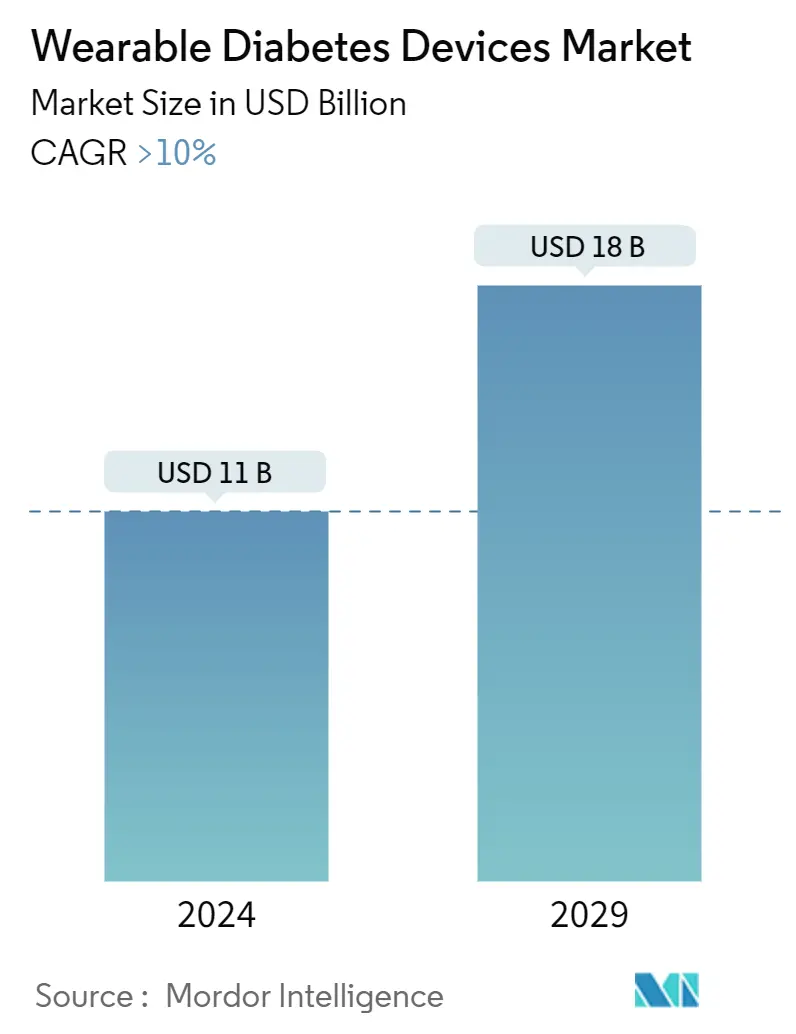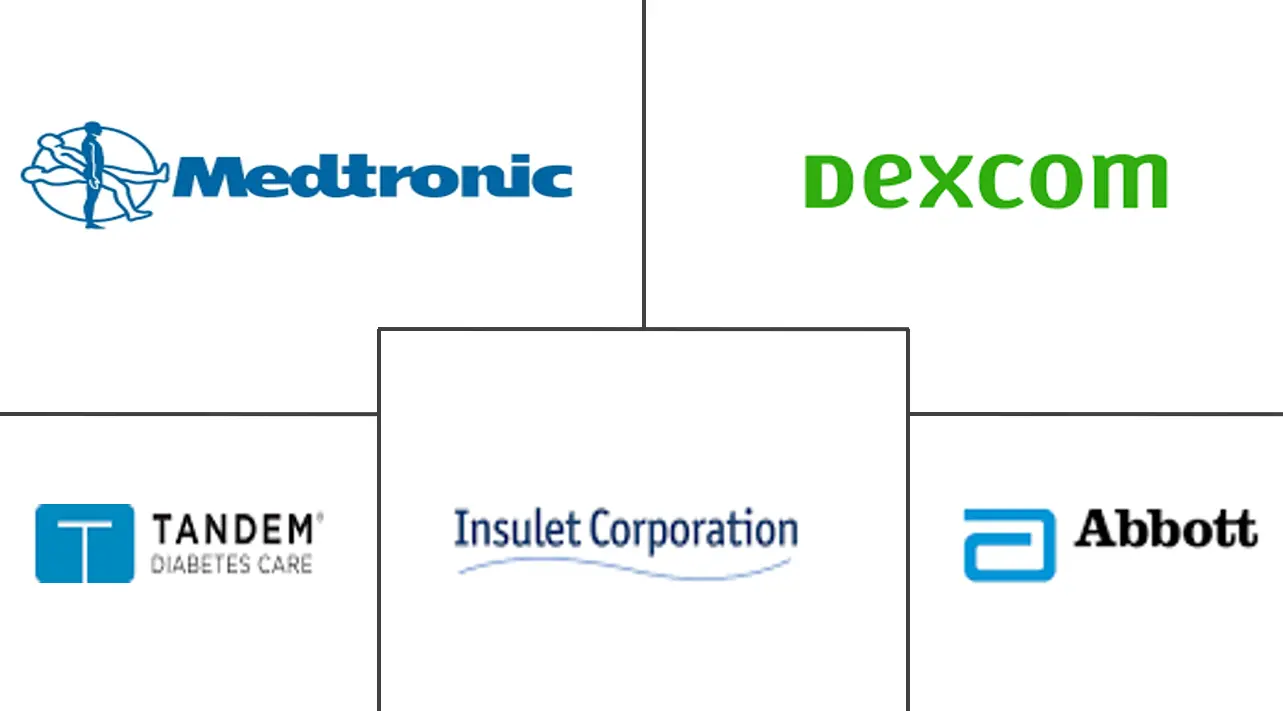Market Size of Wearable Diabetes Devices Industry

| Study Period | 2018-2029 |
| Market Size (2024) | USD 11 Billion |
| Market Size (2029) | USD 18 Billion |
| CAGR (2024 - 2029) | > 10.00 % |
| Fastest Growing Market | Asia Pacific |
| Largest Market | North America |
Major Players
*Disclaimer: Major Players sorted in no particular order |
Wearable Diabetes Devices Market Analysis
The Wearable Diabetes Devices Market size is estimated at USD 11 billion in 2024, and is expected to reach USD 18 billion by 2029, growing at a CAGR of greater than 10% during the forecast period (2024-2029).
Due to their convenience, ability to provide real-time data, and potential to improve glycemic control, wearable devices for diabetes management are becoming increasingly popular. These devices offer a variety of features, such as:
CGM devices are designed to measure glucose levels in the interstitial fluid, which is the fluid that surrounds the cells, every few minutes. This information is then transmitted to a smartphone or other device, providing real-time data about glucose levels. By using CGM, individuals with diabetes can make more informed decisions about their insulin dosage and lifestyle choices.
On the other hand, insulin pumps are devices that deliver insulin to the body in a precise and controlled manner. They can be programmed to administer different basal (background) and bolus (mealtime) insulin doses. Insulin pumps are a viable alternative to multiple daily injections of insulin.
Wearable devices designed for diabetes management offer a range of potential advantages, which include:
Enhanced glycemic control: These devices provide real-time data on glucose levels, enabling individuals with diabetes to make more informed decisions regarding their insulin dosage and lifestyle choices. Consequently, this can result in improved glycemic control and a decreased risk of diabetes-related complications.
Increased convenience: By being wearable, these devices make it more convenient to monitor glucose levels and manage diabetes. This is particularly advantageous for individuals leading busy lifestyles, as it simplifies the process of diabetes management.
Heightened motivation: Wearable devices provide feedback and support, serving as a source of motivation for individuals with diabetes to effectively manage their condition. This encouragement can contribute to better adherence to treatment plans and overall disease management.
Alleviated self-management burden: Automation capabilities of wearable devices, such as insulin delivery and blood glucose monitoring, can alleviate some of the responsibilities associated with self-management for individuals with diabetes. This reduction in burden can enhance the overall experience of managing the condition.
The market for wearable devices for diabetes management is being driven by the numerous benefits they offer.
Wearable Diabetes Devices Industry Segmentation
The wearable diabetes devices market is segmented by device (continuous glucose monitoring devices (sensors and durables), insulin infusion pumps (insulin pump devices, insulin infusion sets, and insulin reservoirs), type (non-invasive glucose monitoring devices, invasive glucose monitoring devices), end user (hospitals, clinics, and home/personal) and geography (North America, Europe, Asia-Pacific, the Middle East, Africa, and Latin America).
The report offers the value (in USD) and volume (in units) for the above segments.
| Device | |||||
| |||||
|
| Type | |
| Non-Invasive Glucose Monitoring Devices | |
| Invasive Glucose Monitoring Devices |
| End User | |
| Hospital/Clinics | |
| Home/Personal |
| Geography | ||||||||||||
| ||||||||||||
| ||||||||||||
| ||||||||||||
| ||||||||||||
|
Wearable Diabetes Devices Market Size Summary
The wearable diabetes devices market is experiencing significant growth, driven by the increasing adoption of these technologies due to their convenience and ability to provide real-time data. These devices, including continuous glucose monitors (CGMs) and insulin pumps, offer enhanced glycemic control, increased convenience, heightened motivation, and reduced self-management burden for individuals with diabetes. As diabetes remains a major global health challenge, the demand for such devices is rising, as they facilitate better management of the condition and help mitigate the risk of complications. The market is characterized by a few key players who are investing in research and development to innovate and strengthen their market presence.
In North America, the focus on preventive healthcare is contributing to the demand for wearable medical devices, which enable continuous monitoring and early detection of health issues. The region's increasing prevalence of chronic diseases, such as diabetes, underscores the need for timely intervention and improved disease management. Despite the challenges posed by inadequate healthcare strategies in many countries, global initiatives by organizations like the WHO and UN aim to enhance healthcare systems and reduce the burden of non-communicable diseases. The market's growth is further supported by regulatory approvals for innovative devices, such as the Beta Bionics iLet ACE Pump and the Eversense E3 CGM System, which offer advanced features for diabetes management.
Wearable Diabetes Devices Market Size - Table of Contents
-
1. MARKET DYNAMICS
-
1.1 Market Overview
-
1.2 Market Drivers
-
1.3 Market Restraints
-
1.4 Porter's Five Forces Analysis
-
1.4.1 Bargaining Power of Suppliers
-
1.4.2 Bargaining Power of Consumers
-
1.4.3 Threat of New Entrants
-
1.4.4 Threat of Substitute Products and Services
-
1.4.5 Intensity of Competitive Rivalry
-
-
-
2. MARKET SEGMENTATION
-
2.1 Device
-
2.1.1 Continuous Glucose Monitoring Devices
-
2.1.1.1 Sensors
-
2.1.1.2 Durables
-
-
2.1.2 Insulin Pumps
-
2.1.2.1 Insulin Pump Devices
-
2.1.2.2 Insulin Infusion Sets
-
2.1.2.3 Reservoirs
-
-
-
2.2 Type
-
2.2.1 Non-Invasive Glucose Monitoring Devices
-
2.2.2 Invasive Glucose Monitoring Devices
-
-
2.3 End User
-
2.3.1 Hospital/Clinics
-
2.3.2 Home/Personal
-
-
2.4 Geography
-
2.4.1 North America
-
2.4.1.1 United States
-
2.4.1.2 Canada
-
2.4.1.3 Rest of North America
-
-
2.4.2 Europe
-
2.4.2.1 France
-
2.4.2.2 Germany
-
2.4.2.3 Italy
-
2.4.2.4 Spain
-
2.4.2.5 United Kingdom
-
2.4.2.6 Russia
-
2.4.2.7 Rest of Europe
-
-
2.4.3 Latin America
-
2.4.3.1 Mexico
-
2.4.3.2 Brazil
-
2.4.3.3 Rest of Latin America
-
-
2.4.4 Asia-Pacific
-
2.4.4.1 Japan
-
2.4.4.2 South Korea
-
2.4.4.3 China
-
2.4.4.4 India
-
2.4.4.5 Australia
-
2.4.4.6 Vietnam
-
2.4.4.7 Malaysia
-
2.4.4.8 Indonesia
-
2.4.4.9 Thailand
-
2.4.4.10 Rest of Asia-Pacific
-
-
2.4.5 Middle East and Africa
-
2.4.5.1 Saudi Arabia
-
2.4.5.2 Iran
-
2.4.5.3 Egypt
-
2.4.5.4 Oman
-
2.4.5.5 South Africa
-
2.4.5.6 Rest of Middle East and Africa
-
-
-
Wearable Diabetes Devices Market Size FAQs
How big is the Wearable Diabetes Devices Market?
The Wearable Diabetes Devices Market size is expected to reach USD 11 billion in 2024 and grow at a CAGR of greater than 10% to reach USD 18 billion by 2029.
What is the current Wearable Diabetes Devices Market size?
In 2024, the Wearable Diabetes Devices Market size is expected to reach USD 11 billion.

